An online project under the direction of the CAPE ANN MUSEUM
inv. 253
Clipper Ship "Southern Cross" in Boston Harbor
Clipper Ship "Southern Cross" Leaving Boston Harbor; Ship "Southern Cross" in Boston Harbor; Ship "Southern Cross" Leaving Boston Harbor
1851 Oil on canvas 34 1/4 x 47 in. (87 x 119.4 cm) Signed and dated lower right: F.H. Lane 1851
|
Explore catalog entries by keywords view all keywords »
Historical Materials
Below is historical information related to the Lane work above. To see complete information on a subject on the Historical Materials page, click on the subject name (in bold and underlined).
During the years after the war of 1812 and before the Civil War, the port of Boston was a center of American deep-water shipping. Trading with China, India, and the West Indies, which had fueled maritime growth in the early years of the century gave way to re-exporting these goods and foreign trade based on the shoe and textile trades. Although second to New York in terms of shipping tonnage, many of New York's shipbuilders and merchants were Boston based. In addition, ship building continued in Boston. Also, the coastal trade (the domestic trade up and down the coast) was still the most efficient way to transport goods and passengers, and accounts for much of the tonnage and shipping traffic.
Although dwarfed by New York, Boston was an active port in the 1840s and 1850s. Its registered tonnage rose from 149,186 in 1840 to 270,510 in 1850. The harbor was a crowded place. For example, on September 18, 1850, 32 ships, 49 barks, 47 brigs, and 52 schooners were reported at Boston.(1)
In 1849, foreign entries at Boston included 215 ships, 305 barks, 908 brigs, and 52 schooners. Coastwise arrivals included 193 ships, 488 barks, 1087 brigs, 4287 schooners, 89 sloops, and 65 schooners.(2)
(1) W.H. Bunting, p.8.
(2) Ibid.
For more information:
Samuel Eliot Morrison, The Maritime History of Massachusetts, 1783-1860
W.H. Bunting, Portrait of a Port, Boston 1852-1914 Cambridge: The Belknap Press of Harvard University, 1971.
Printed map inside Boston Almanac
Published by B. B. Mussey & Co. and Thomas Groom, Boston
Cape Ann Museum Library & Archive (R910.45 B65 1848)
Map at front of almanac with Tremont Temple highlighted.
Also filed under: Boston City Views » // Maps » // Tremont Temple »
Harvard Depository: Widener (NAV 578.57)
For digitized version, click here.
Also filed under: Signal Systems (Flags & Maritime Codes) »
Tinted lithograph with hand coloring
13 7/8 x 22 3/8 in.
Boston Athenaeum
From Sally Pierce and Catharina Slautterback, Boston Lithography, 1825–1880: The Boston Atheneaum Collection (Boston: Athenaeum, 1991): "Tidd drew this print when he was a consulting engineer for Simpson's. He has depicted the clipper ship 'Southern Cross' in the dry dock. Built in 1851, she was known for having sailed from San Francisco to Hong Kong in the record breaking time of thirty-two days. The Bethlehem Ship Building Company eventually took over this location and operated a dry dock there until the mid 1940s."
Also filed under: "Southern Cross" (Clipper Ship) » // M. M. Tidd, Lith. – Boston »
Library of Congress Catalog Number 2004671768
Also filed under: "Britannia" (Cunard Steamship) »
1853
Bostonian Society (1884.0209)
Also filed under: Scott, John W. A. »
1 print : lithograph, tinted ; image 50.3 x 111.9 cm., 68.7 x 121.2 cm.
View of the city of Boston from East Boston showing Boston Harbor. The wharves of East Boston can be seen in the foreground.
Number nine of thirty-eight city views published in "Whitefield's Original Views of (North) American Cities (Scenery).
On stone by Charles W. Burton after a drawing by Edwin Whitefield.
Inscribed in brown ink lower right corner of sheet: "Boston Athenaeum from Josiah Quincy. September 28, 1848."
Local Notes:#1848.1.
The medium clipper ship "Southern Cross" was built in 1851 by E. and H.O. Briggs at their shipyard in South Boston for the shipping firm of Baker & Morrill of Boston. She was named for what her owners regarded as the most beautiful constellation in the Southern Hemisphere. Recent claims that the Briggs yard was in East Boston are not supported by a very detailed contemporary newspaper account (very likely The Boston Atlas), which gave South Boston as the yard's location.
"Southern Cross" experienced more than her fair share of adversity, with contrary winds, dismastings, and a fire, preventing her from making the quick passages her owners expected. Her career ended abruptly when the Confederate cruiser "Florida" captured and burned her in June, 1863.
– Erik Ronnberg
Reference:
Octavius T. Howe, and Frederick C. Matthews. American Clipper Ships: 1833–1858 (Salem, MA: Marine Research Society, 1927).
Tinted lithograph with hand coloring
13 7/8 x 22 3/8 in.
Boston Athenaeum
From Sally Pierce and Catharina Slautterback, Boston Lithography, 1825–1880: The Boston Atheneaum Collection (Boston: Athenaeum, 1991): "Tidd drew this print when he was a consulting engineer for Simpson's. He has depicted the clipper ship 'Southern Cross' in the dry dock. Built in 1851, she was known for having sailed from San Francisco to Hong Kong in the record breaking time of thirty-two days. The Bethlehem Ship Building Company eventually took over this location and operated a dry dock there until the mid 1940s."
Also filed under: Boston Harbor » // M. M. Tidd, Lith. – Boston »
In the ninteenth century, the term "bark" was applied to a large sailing vessel having three masts, the first two (fore and main) being square-rigged; the third (mizzen), fore-and-aft rigged. The reduced square-rig made the vessel easier and more economical to handle, using a smaller crew. (1)
Barks had significant presence in mid-nineteenth-century America, as indicated by Lane’s depictions of them. Hardly any are to be found in his scenes of major ports, but some do appear in his Cape Ann scenes (see The Fort and Ten Pound Island, Gloucester (Harbor Scene), 1848 (inv. 58), View of Gloucester, 1859 (inv. 91), Gloucester Harbor, 1850s (inv. 391), and Bark "Eastern Star" of Boston, 1853 (inv. 571)), also in views of other small ports and of coastal shipping (see Clipper Ship "Southern Cross" in Boston Harbor, 1851 (inv. 253), Merchantmen Off Boston Harbor, 1853 (inv. 267), Approaching Storm, Owl's Head, 1860 (inv. 399), and Bark "Mary" (inv. 629)).
Brigs, and to a lesser extent ships, were the vessels of choice for Gloucester’s foreign trade in the first half of the nineteenth century. They brought cargos from the West Indies, South America, and Europe, anchoring in the deeper parts of the Inner Harbor while lighters off-loaded the goods and landed them at the wharves in Harbor Cove, by then too shallow for the newer, larger merchant vessels coming into use. (2) By mid-century, barks were gradually replacing brigs and ships, while the trade with Surinam was removed to Boston in 1860. (3)
Some bulk cargos still had to be landed in Gloucester, salt for curing fish being the most important. “Salt barks” brought Tortugas salt from the West Indies, and in the 1870s, Italian salt barks began bringing Trapani salt from Sicily. The importation of salt by sailing ships ended with the outbreak of World War I. (4)
The term barkentine, like the bark, pre-dates the nineteenth century, but in the mid- to late 1800s referred to a large vessel of three masts (or more), with only the fore mast square-rigged, the others being fore-and-aft-rigged. In Lane’s time, the term was little known in the United States, while many other names were coined for the rig. One of these early terms was demi-bark, probably from the French demi-barque, which was applied to a very different kind of vessel. (5) Lane’s depictions of these rigs include a lithograph of the steam demi-bark "Antelope" View of Newburyport, (From Salisbury), 1845 (inv. 499) and at least three depictions of Cunard steamships The "Britannia" Entering Boston Harbor, 1848 (inv. 49), Cunard Steamship Entering Boston Harbor (inv. 197), and Cunard Liner "Britannia", 1842 (inv. 259). (6) None of these subjects typify the barkentine rig as applied to sails-only rigs as they developed in the years after Lane’s death.
– Erik Ronnberg (May, 2015)
References:
1. R[ichard] H[enry] Dana, Jr., The Seaman's Friend (Boston; Thomas Groom & Co., 1841. 13th ed., 1873), 97 and Plate IV with captions; and M.H. Parry, et al., Aak to Zumbra: A Dictionary of the World's Watercraft (Newport News, VA: The Mariners’ Museum, 2000), 43.
2. Alfred Mansfield Brooks, Gloucester Recollected (Gloucester, MA: Peter Smith, 1974), 56, note 10; 67, note 7.
3. James R. Pringle, History of the Town and City of Gloucester (1892. Reprint: Gloucester, MA, 1997), 106–08.
4. Raymond McFarland, A History of the New England Fisheries (Philadelphia: University of Pennsylvania, 1911), 95–96; and Mark Kurlansky, Salt: A World History (New York: Walker & Co., 2002), 419–420.
5. Parry, 44, 167. Dana has neither definition nor illustration of this rig.
6. J[ohn] W. Griffiths, “The Japan and China Propeller Antelope," U.S. Nautical Magazine III (October 1855): 11–17. This article includes an impression of Lane’s lithograph on folded tissue.
Stereograph card
Cape Ann Museum Library & Archive
This view of Gloucester's Inner Harbor shows three square-rigged vessels in the salt trade at anchor. The one at left is a (full-rigged) ship; the other two are barks. By the nature of their cargos, they were known as "salt ships" and "salt barks" respectively. Due to their draft (too deep to unload at wharfside) they were partially unloaded at anchor by "lighters" before being brought to the wharves for final unloading.
– Erik Ronnberg
Also filed under: Historic Photographs » // Salt » // Waterfront, Gloucester »
Hermaphrodite brigs—more commonly called half-brigs by American seamen and merchants—were square-rigged only on the fore mast, the main mast being rigged with a spanker and a gaff-topsail. Staysails were often set between the fore and main masts, there being no gaff-rigged sail on the fore mast. (1)
The half-brig was the most common brig type used in the coasting trade and appears often in Lane’s coastal and harbor scenes. The type was further identified by the cargo it carried, if it was conspicuously limited to a specialized trade. Lumber brigs (see Shipping in Down East Waters, 1854 (inv. 212) and View of Southwest Harbor, Maine: Entrance to Somes Sound, 1852 (inv. 260)) and hay brigs (see Lighthouse at Camden, Maine, 1851 (inv. 320)) were recognizable by their conspicuous deck loads. Whaling brigs were easily distinguished by their whaleboats carried on side davits (see Ships in the Harbor (not published)). (2)
– Erik Ronnberg
References:
1. M.H. Parry, et al., Aaak to Zumbra: A Dictionary of the World's Watercraft Newport News, VA: The Mariners’ Museum, 2000), 268, 274; and A Naval Encyclopaedia (L.R. Hamersly & Co., 1884. Reprint: Detroit, MI: Gale Research Company, 1971), 93, under "Brig-schooner."
2. W.H. Bunting, An Eye for the Coast (Gardiner, ME: Tilbury House: 1998), 52–54, 68–69; and W.H. Bunting, A Day's Work, part 1 (Gardiner, ME: Tilbury House: 1997), 52.
The term "ship," as used by nineteenth-century merchants and seamen, referred to a large three-masted sailing vessel which was square-rigged on all three masts. (1) In that same period, sailing warships of the largest classes were also called ships, or more formally, ships of the line, their size qualifying them to engage the enemy in a line of battle. (2) In the second half of the nineteenth century, as sailing vessels were replaced by engine-powered vessels, the term ship was applied to any large vessel, regardless of propulsion or use. (3)
Ships were often further defined by their specialized uses or modifications, clipper ships and packet ships being the most noted examples. Built for speed, clipper ships were employed in carrying high-value or perishable goods over long distances. (4) Lane painted formal portraits of clipper ships for their owners, as well as generic examples for his port paintings. (5)
Packet ships were designed for carrying capacity which required some sacrifice in speed while still being able to make scheduled passages within a reasonable time frame between regular destinations. In the packet trade with European ports, mail, passengers, and bulk cargos such as cotton, textiles, and farm produce made the eastward passages. Mail, passengers (usually in much larger numbers), and finished wares were the usual cargos for return trips. (6) Lane depicted these vessels in portraits for their owners, and in his port scenes of Boston and New York Harbors.
Ships in specific trades were often identified by their cargos: salt ships which brought salt to Gloucester for curing dried fish; tea clippers in the China Trade; coffee ships in the West Indies and South American trades, and cotton ships bringing cotton to mills in New England or to European ports. Some trades were identified by the special destination of a ship’s regular voyages; hence Gloucester vessels in the trade with Surinam were identified as Surinam ships (or barks, or brigs, depending on their rigs). In Lane’s Gloucester Harbor scenes, there are likely (though not identifiable) examples of Surinam ships, but only the ship "California" in his depiction of the Burnham marine railway in Gloucester (see Three Master on the Gloucester Railways, 1857 (inv. 29)) is so identified. (7)
– Erik Ronnberg
References:
1. R[ichard)] H[enry] Dana, Jr., The Seaman’s Friend, 13th ed. (Boston: Thomas Groom & Co., 1873), p. 121 and Plate IV with captions.
2. A Naval Encyclopaedia (Philadelphia: L. R. Hamersly & Co., 1884), 739, 741.
3. M.H. Parry, et al., Aak to Zumbra: A Dictionary of the World’s Watercraft (Newport News, VA: The Mariners’ Museum, 2000), 536.
4. Howard I. Chapelle, The History of American Sailing Ships (New York: W.W. Norton & Co., 1935), 281–87.
5. Ibid.
6. Howard I. Chapelle, The National Watercraft Collection (Washington, DC: Smithsonian Institution, 1960), 26–30.
7. Alfred Mansfield Brooks, Gloucester Recollected: A Familiar History (Gloucester, MA: Peter Smith, 1974), 67–69.
Photograph
From American Clipper Ships 1833–1858, by Octavius T. Howe and Frederick C. Matthews, vol. 1 (Salem, MA: Marine Research Society, 1926).
Photo caption reads: "'Golden State' 1363 tons, built at New York, in 1852. From a photograph showing her in dock at Quebec in 1884."
Also filed under: "Golden State" (Clipper Ship) »
Oil on canvas
24 x 35 in.
Peabody Essex Museum, Salem, Mass.
Walters' painting depicts the "Nonantum" homeward bound for Boston from Liverpool in 1842. The paddle-steamer is one of the four Clyde-built Britannia-class vessels, of which one is visible crossing in the opposite direction.
View related Fitz Henry Lane catalog entries (2) »
Also filed under: Packet Shipping » // Walters, Samuel »
The Whitehall Boat, like the yawl boat, is an early nineteenth-century refinement of an earlier ship's boat type—very likely the gigs of warships. Builders of the earliest examples are believed to have been former navy shipyard employees whose knowledge was put to use building similar boats in their shops on Whitehall Street in lower Manhattan. Recognized as a distinct small boat type in the 1830s, by mid-nineteenth century the Whitehall Boat was in use in most American seaports. (1)
Lane depicted Whitehall Boats in a number of his paintings of major ports, including New York Harbor, c.1855 (inv. 46) (right center foreground), which shows a large example, rowed by four men witha single passenger in the stern, illustrating one of its chief uses as a water taxi. These craft were also used by ship chandlers to deliver ship supplies, and most notoriously by "crimps" who used them to deliver drunken seamen to outbound ships needing crews. Not intended for use in open sea, their light yet strong construction, fine lines, and maneuverability made them ideal for in-harbor work. (2)
Other Whitehall boats appear in the foregrounds of Boston and other unidentified major port scenes (see New England Harbor at Sunrise, c.1850 (inv. 27), Brig "Antelope" in Boston Harbor, 1863 (inv. 43), The "Britannia" Entering Boston Harbor, 1848 (inv. 49), Boston Harbor, Sunset, 1850–55 (inv. 242), The "Constitution" in Boston Harbor, c.1848–49 (inv. 243), and Clipper Ship "Southern Cross" in Boston Harbor, 1851 (inv. 253)).
References:
1. Howard I. Chapelle, American Small Sailing Craft (New York: W.W. Norton & Co., 1951), 195–96.
2. Ibid., 196–99.
Oil on canvas
36 x 60 1/4 in.
Museum of Fine Arts, Boston, Gift of Maxim Karolik for the M. and M. Karolik Collection of American Paintings, 1815–65 (48.446)
Detail of Whitehall boat.
Also filed under: New York Harbor »
The yawl boat was a ninteenth-century development of earlier ships' boats built for naval and merchant use. Usually twenty feet long or less, they had round bottoms and square sterns; many had raking stem profiles. Yawl boats built for fishing tended to have greater beam than those built for vessels in the coastal trades. In the hand-line fisheries, where the crew fished from the schooner's rails, a single yawl boat was hung from the stern davits as a life boat or for use in port. Their possible use as lifeboats required greater breadth to provide room for the whole crew. In port, they carried crew, provisions, and gear between schooner and shore. (1)
Lane's most dramatic depictions of fishing schooners' yawl-boats are found in his paintings Gloucester Outer Harbor, from the Cut, 1850s (inv. 109) and /entry:311. Their hull forms follow closely that of Chapelle's lines drawing. (2) Similar examples appear in the foregrounds of Gloucester Harbor, 1852 (inv. 38), Ships in Ice off Ten Pound Island, Gloucester, 1850s (inv. 44), and The Fort and Ten Pound Island, Gloucester, Massachusetts, 1847 (inv. 271). A slightly smaller example is having its bottom seams payed with pitch in the foreground of Gloucester Harbor, 1847 (inv. 23). In Gloucester Inner Harbor, 1850 (inv. 240), a grounded yawl boat gives an excellent view of its seating arrangement, while fishing schooners in the left background have yawl boats hung from their stern davits, or floating astern.
One remarkable drawing, Untitled (inv. 219) illustrates both the hull geometry of a yawl boat and Lane's uncanny accuracy in depicting hull form in perspective. No hull construction other than plank seams is shown, leaving pure hull form to be explored, leading in turn to unanswered questions concerning Lane's training to achieve such understanding of naval architecture.
– Erik Ronnberg
References:
1. Howard I. Chapelle, American Small Sailing Craft (New York: W.W. Norton & Co., 1951), 222–23.
2. Ibid., 223.
Oil on canvas
12 1/8 x 19 3/4 in.
Museum of Fine Arts, Boston, Bequest of Martha C. Karolik for the M.and M. Karolik Collection of American Paintings, 1815-1865 (48.447)
A schooner's yawl lies marooned in the ice-bound harbor in this detail.
The ensign of the United States refers to the flag of the United States when used as a maritime flag to indentify nationality. As required on entering port, a vessel would fly her own ensign at the stern, but a conventional token of respect to the host country would be to fly the flag of the host country (the United States in Boston Harbor, for example) at the foremast. See The "Britannia" Entering Boston Harbor, 1848 (inv. 49) for an example of a ship doing this. The American ensign often had the stars in the canton arranged in a circle with one large star in the center; an alternative on merchant ensigns was star-shaped constellation. In times of distress a ship would fly the ensign upside down, as can be seen in Wreck of the Roma, 1846 (inv. 250).
The use of flags on vessels is different from the use of flags on land. The importance and history of the flagpole in Fresh Water Cove in Gloucester is still being studied.
The modern meaning of the flag was forged in December 1860, when Major Robert Anderson moved the U.S. garrison from Fort Moultrie to Fort Sumter in Charleston Harbor. Adam Goodheart argues this was the opening move of the American Civil War, and the flag was used throughout northern states to symbolize American nationalism and rejection of secessionism.
Before that day, the flag had served mostly as a military ensign or a convenient marking of American territory, flown from forts, embassies, and ships, and displayed on special occasions like American Independence day. But in the weeks after Major Anderson's surprising stand, it became something different. Suddenly the Stars and Stripes flew—as it does today, and especially as it did after the September 11 attacks in 2001—from houses, from storefronts, from churches; above the village greens and college quads. For the first time American flags were mass-produced rather than individually stitched and even so, manufacturers could not keep up with demand. As the long winter of 1861 turned into spring, that old flag meant something new. The abstraction of the Union cause was transfigured into a physical thing: strips of cloth that millions of people would fight for, and many thousands die for.
– Adam Goodheart, Prologue of 1861: The Civil War Awakening (2011).
Stereograph card
Cape Ann Museum Library & Archive
A view of a Cove on the western side of Gloucester Harbor, with the landing at Brookbank. Houses are seen in the woods back. A boat with two men is in the foreground.
Also filed under: Brookbank » // Fresh Water Cove » // Historic Photographs »
Courtesy American Antiquarian Society, Worcester, Mass. (CL.F9116.011.1854 CL.F9116.011.1854)
Also filed under: Oak Hall »
Courtesy American Antiquarian Society, Worcester, Mass. (CL.F9116.011.1854)
Also filed under: Oak Hall »
The use of signal flags, for ship-to-ship communication, generally preceded land-based chains of maritime semaphore stations, the latter using flags or rotating arms, until the advent of the electric or magnetic telegraph.
Until the end of the Napoleonic wars, merchant ships generally sailed in convoy as ordered by the escorting warship(s) using a few simple flags. Peace brought independent voyaging, the end of the convoy system, and the realization by various authorities that merchant vessels now needed their own separate means of signaling to each other. This resulted in a handful of rival codes, each with its individual flags and syntax. In general, they each had a section enabling ship identification and also a "vocabulary" section for transmitting selected messages. It was not until 1857 that a common Commercial Code became available for international use, only gradually replacing the earlier ones. All existed side by side for a decade or two.
Signal systems for American ships were originally intended to identify a vessel by name and owner; only later were more advanced systems developed to convey messages. Most basic were private signals, or "house flags", each of a different design or pattern, identifying the vessel's owner; identification charts were local and poorly distributed, limiting their usefulness. A secondary signal, a flag or large pennant bearing the vessel's name, was sometimes flown by larger ships, but pictorial records of them are uncommon. These private signal flags usually flew from the foremasthead or main masthead if a three master ship. Pilot boats had their own identifying flags, blue and white as seen in Spitfire Entering Boston Harbor (inv. 536). Small vessels, such as schooners, often had a "tell-tale" pennant, an often-unmarked and often red flag, that was used to determine wind direction.
A numerical code flag system, identifying vessels by the code numbers, was introduced by Captain Frederick Marryat R.N. in 1817 for English vessels. American vessels soon adopted this system. Elford's "marine telegraphic system" was the first American equivalent to the Marryat code flags, first issued in 1823, and with changes, remaining in use until the late 1850s. Most of the signal flags on vessels depicted by Lane use Elford's; Brig "Antelope" in Boston Harbor, 1863 (inv. 43) is a noteworthy example of his depiction of Marryat's. The Elford's Code was popular in America on account of its simplicity and only required six blue and white flags. Eventually these changed to red and white, although it is unclear exactly when this happened. Instructions and a key ot the Elford's Code's use are included in successive editions of the Boston Harbor Signal Book.
Whereas the other codes employ at least ten flags of diverse shapes and colours, there are only six Elford flags in total, representing the numbers one to six. All are uniformly rectangular and monochrome in colour (either blue and white or red and white—or even black and white as in an early photograph). Selected from these six flags each individual vessel is allotted a combination of four flags to be prominently displayed as a vertical hoist. Reading from above down these convey its "designated number." Armed with this number and the type of vessel (e.g. ship, bark, brig, schooner /or steamer) the subject can be uniquely identified by reference to a copy of the Boston Harbor Signal Book for the appropriate year.
– A. Sam Davidson
As reproduced in Yankee Sailing Ship Cards by Allan Forbes and Ralph M. Eastman (Boston: State Street Trust Company, 1948).
Also filed under: "Eastern Star" (Bark) » // Forbes, Robert Bennet »
Harvard Depository: Widener (NAV 578.57)
For digitized version, click here.
Also filed under: Boston Harbor »
Boston: Eastburn's Press
New York Public Library
Complete book is included in Google Books, click here.
In The American Neptune 3, no. 3 (July 1943): 205–21.
Peabody Essex Museum
Descriptions of Marryat, Elford, Rogers, and commercial code signal systems, and private signals. Includes illustrations of flag systems with color keys.
Vessel ornamentation assumed two forms: carvings and color schemes. Carvings, or "ship carvings," as they are called by maritime scholars, are usually crafted in wood and painted or gilt. Many vessels were too small or their owners too frugal to permit carved embellishments, in which cases the enhancement of the vessel's color scheme was a practical alternative. This can be seen in many of the coastal vessels along the new England coast. Pinkies and Chebacco boats had handsome color schemes using only black and green with white sheer lines and limited use of red and yellow. Other combinations of inexpensive pigments were used to improve the simple looks of sloops and schooners in the packet trade, while small pleasure craft and pilot schooners enhanced their appearance in similar ways. Clipper ship owners, finding their vessels' appearance impressive without adding color, settled for unrelieved black hulls. Naval vessels as well preserved their formidable looks with black, relieved only with a white belt in way of the gunports.
The more elaborate ship carvings can be classified in the following categories:
Billetheads: mounted on the bow, at the end of a simple gammon knee, or on the forward end of an elaborate stem-head, they can be scrolls of less or greater intricacy, or sometimes the heads of animals, eagles being the most common. Examples of a sea serpent's head, a pointing hand, and other animal heads have been found. (See Brig "Cadet" in Gloucester Harbor, late 1840s (inv. 13); Brig "Antelope" in Boston Harbor, 1863 (inv. 43); and Brig Off the Maine Coast, 1851 (inv. 241))
Figureheads: mounted on bows of larger vessels, often with elaborate stem joinerwork (trailboards and headboards with associated knees and rails). Usually these were full-length figures representing the ship's owner, a famous citizen, a mythological person or animal, or an eagle. (See Portrait of the "National Eagle", 1853 (inv. 35) (eagle); New York Harbor, c.1855 (inv. 46); The "Britannia" Entering Boston Harbor, 1848 (inv. 49) (female figures); The Ships "Winged Arrow" and "Southern Cross" in Boston Harbor, 1853 (inv. 54) (dragon and eagle); "Starlight" in Harbor, c.1855 (inv. 249) (dragon); and Steam demi bark Antelope, 615 tons, c.1855 (inv. 375) (antelope))
Trailboards: carved vines or scrollwork abaft the figurehead which trail aft along the stem head in a graceful descending arc, terminating at the hawse pipes. They are usually gilt and frequently ornamented with carved rosettes and other devices. (See Brig "Cadet" in Gloucester Harbor, late 1840s (inv. 13); Portrait of the "National Eagle", 1853 (inv. 35); Brig "Antelope" in Boston Harbor, 1863 (inv. 43); New York Harbor, c.1855 (inv. 46); and The Ships "Winged Arrow" and "Southern Cross" in Boston Harbor, 1853 (inv. 54))
Headboards: boards mounted to headrails connecting the figurehead to the ship's mainrail at the catheads. While seldom given any decorative carvings, the vessel's nameboards were often mounted to them. (See Brig "Cadet" in Gloucester Harbor, late 1840s (inv. 13); Portrait of the "National Eagle", 1853 (inv. 35); Brig "Antelope" in Boston Harbor, 1863 (inv. 43); The Ships "Winged Arrow" and "Southern Cross" in Boston Harbor, 1853 (inv. 54); Clipper Ship "Southern Cross" in Boston Harbor, 1851 (inv. 253); and Mary Ann, 1846 (inv. 309))
Catheads: Carved lion heads mounted on the outboard ends of the cathead knees. This term is so archaic that the knees and carvings are treated as one and the same, as in their use, i.e. "catting the anchor" (securing the anchor ring to the cathead). (See Brig "Antelope" in Boston Harbor, 1863 (inv. 43); and An American Frigate Hove-to Off the New England Coast (inv. 535))
Quarterboards: Name boards mounted to the vessel's side near the stern, they usually had ornamental edge moldings and sometimes stars or simple scrollwork at each end of the name. (See Portrait of the "National Eagle", 1853 (inv. 35); Mary Ann, 1846 (inv. 309); and Spitfire Entering Boston Harbor (inv. 536))
Transom arches: arch-form panels fitted to the transom, often over gallery lights (windows) or other carvings. They usually have edge moldings, decorative scrollwork, and sometimes a bust or other carved figure at the center.
Other transom carvings: carved eagles, busts, scrollwork and coats of arms can occupy the space between the transom arch and the sternboard. If galleries are present, carved scrollwork may be fitted between the frames of the gallery lights. (See Boston Harbor, c.1850 (inv. 48); The Topsail Schooner "Kamehameha III" in Boston Harbor, 1846 (inv. 301) (eagle); Baltimore Harbor, 1850 (inv. 400) (eagle); and Rough Sea, Schooners, c.1856 (not published) (eagle and flags))
Sternboard: often the bottom plank of the transom on which the vessel's name is carved or painted, seldom with decoration (stars or scrollwork). There is usually simple protective molding above and below the lettering.
Sideboards, or gangway boards: boards on either side of an entry way at main rail level on a large ship, usually between the main and mizen masts. They are carved and painted or (if of fine hardwood) varnished. Most commonly seen on larger vaval vessels, packet ships, and clipper ships.
– Erik Ronnberg
References:
1. Brewington, M. V., Shipcarvers of North America, (Barre, MA: Barre Publishing Co., 1962).
2. The American Neptune, Pictorial Supplement XIX, "The Art of the Shipcarver" (Salem, MA: The Peabody Museum, 1977).
3. Ship Figureheads (Boston: State Street Trust Co., n.d.).
4. Edouard A. Stackpole, Figureheads & Carvings at Mystic Seaport (Mystic, CT: The Marine Historical Association, Inc., 1964).
Carved wood with paint and gilt
12 x 22 x 8 in.
Cape Ann Museum. Gift of George W. Woodbury, 1936 (747)
This sea serpent billet head came from the schooner "Diadem" which was built in Essex, Massachusetts, in 1855 and owned by D. Elwell Woodbury and John H. Welsh of Gloucester.
Sea serpents were reportedly sighted here on Cape Ann from colonial times through the mid-nineteenth century. In 1817, more than 50 people, many of them prominent members of the community, reported seeing a serpent in the waters of Gloucester Harbor just off Pavilion Beach. So credible were the reports that the Linnaean Society of New England collected depositions from witnesses and published their findings in a small pamphlet entitled Report of a Committee of the Linnaean Society of New England relative to a Large Marine Animal Supposed to be A Serpent, seen Near Cape Ann, Massachusetts, in August 1817.
Also filed under: Objects » // Pavilion (Publick) Beach »
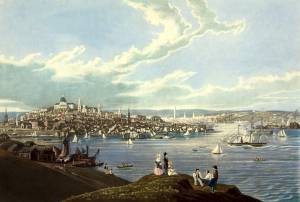
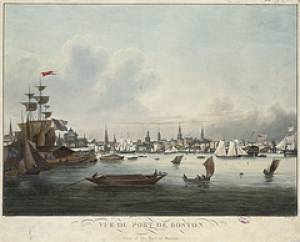

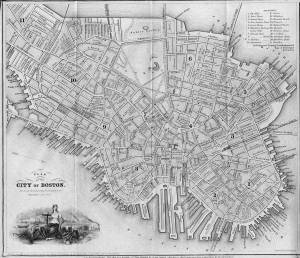
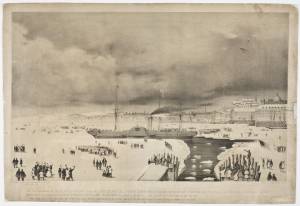

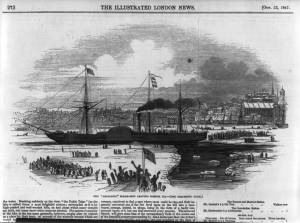

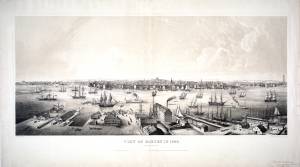


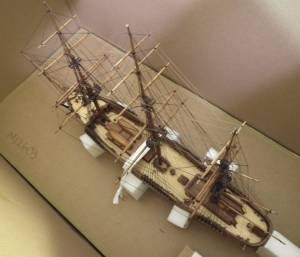
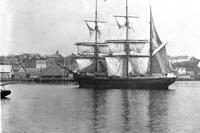

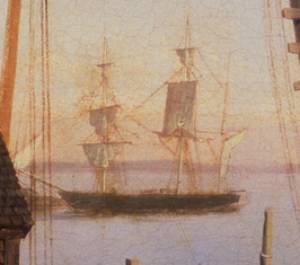


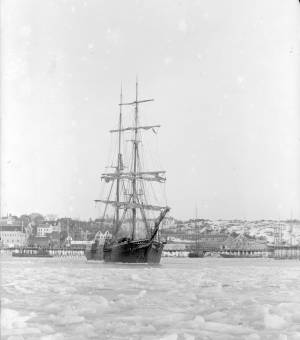

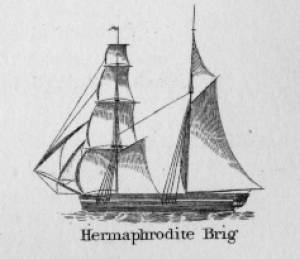

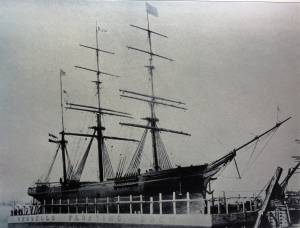
_sm.jpg)

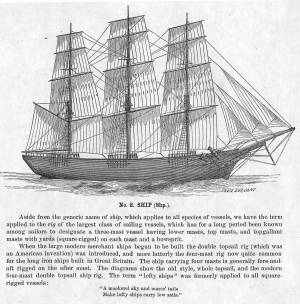
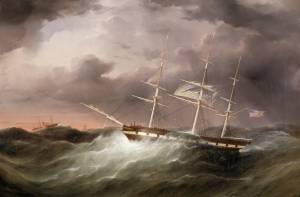




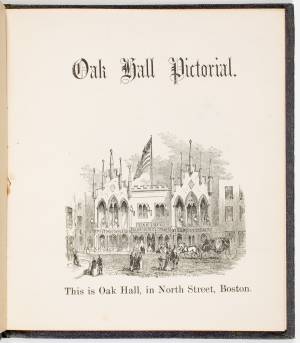
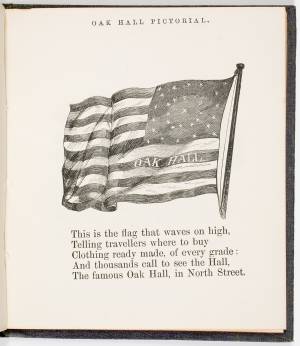



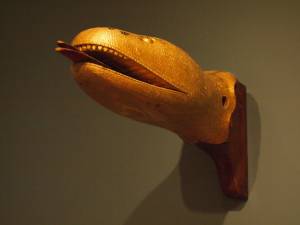
Commentary
Lane is known to have painted two pictures of "Southern Cross": this painting and The Ships "Winged Arrow" and "Southern Cross" in Boston Harbor, 1853 (inv. 54). When this picture was painted in 1851, the medium clipper "Southern Cross" had just been finished by a shipyard in South Boston. She was named for what her owners regarded as the most beautiful constellation in the Southern Hemisphere.
The vessel "Southern Cross" experienced more than her fair share of adversity, with contrary winds, dismastings, and a fire preventing her from making the quick passages her owners expected. Her career ended abruptly when the Confederate cruiser "Florida" captured and burned her in June of 1863.
– Erik Ronnberg
[+] See More